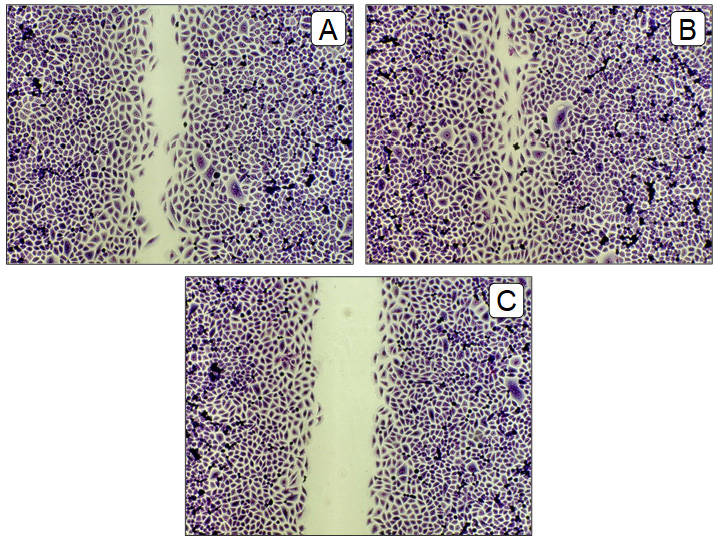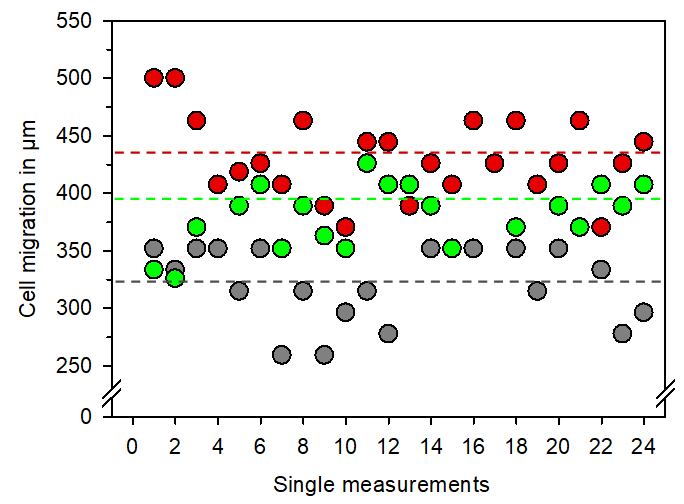ABSTRACT
Quantum entanglement is a phenomenon in theoretical physics that happens when pairs or groups of particles are generated in such a way that the quantum state of each particle cannot be described independently of the others – even when the particles are separated by a large distance. In this in vitro study, the effect of 90.10. quantum entanglement on cell regeneration/wound healing of cultured connective tissue fibroblasts was examined. A 90.10.-CUBE Version 4.0 was used for the investigations of this study. The 90.10.-CUBE was located in Akumal Quintana Roo, Mexico, 8,603 kilometers air-line distance from our laboratory. For quantum physical product refinement by 90.10. quantum entanglement, photographs of the cell culture dishes with and without seeded and attached cells with the corresponding target coordinates of the object were placed in the 90.10.-CUBE and left there for the duration of the test. Control dishes were not treated and were incubated in the same incubator with a distance of at least 30 to 40 cm to the treated dishes. All experiments demonstrated that 90.10. quantum entanglement caused an increased and statistically significant closure of the cell-free space when compared with untreated control cultures. This was due to a stimulation of cell migration and proliferation of connective tissue fibroblasts. The results demonstrate the effectiveness of the 90.10. quantum entanglement on the stimulation of regeneration by using current cell biological test systems.
Keywords: Quantum Energy; Quantum Entanglement; Cell Regeneration; Connective Tissue Fibroblasts; Cell Culture
Introduction
As stated by Horodecki et al. [1], it was Einstein, Podolsky, and Rosen (EPR) and Schrödinger who first recognized a “spooky” feature of quantum machinery which lies at the center of interest of physics of the 21st century“ [2,3]. It describes a physical phenomenon that occurs when a group of particles interact in such a way that the quantum state of each particle of this group cannot be described independently from the state of the others. This also includes a state when the particles are separated by a long distance. The term for this phenomenon is now called quantum entanglement and was originally called by Schrödinger et al. as Verschränkung [4- 6]. Recent advances in quantum information theory reveal the deep connections between entanglement and thermodynamics, manybody theory, quantum computing and its link to macroscopicity [7].
According to the homepage of the manufacturer, the 90.10.- CUBE is a quantum processor generating harmonizing quantum energy which creates a torus field around the cube. Only in its center or by teleporting quantum energy other matter can be permanently quantum-physically refined with energy and frequencies. The intensive increase in energy that takes place is referred to as quantum physical product refinement. The quantum physical product refinement can also be carried out over a longer distance by using the possibilities of 90.10. quantum entanglement.
In this in vitro study, we examined the effect of 90.10. quantum entanglement on cell regeneration/wound healing. In vivo, the cell regeneration/wound healing process can be divided into three distinct phases: Cleaning phase, granulation phase and differentiation phase [8-10]. In this study, the granulation phase, characterized by the occurrence of migration and proliferation of fibroblasts for closing a skin defect [11], was simulated to examine the effect of quantum entanglement by the 90.10.-CUBE.
Materials and Methods
90.10.-CUBE
A 90.10.-CUBE Version 4.0 was used for the investigations of this study. The 90.10.-CUBE was located in Akumal Quintana Roo, Mexico, 8,603 kilometers air-line distance from our laboratory. For quantum physical product refinement by 90.10. quantum entanglement, photographs of the cell culture dishes with and without seeded and attached cells with the corresponding target coordinates of the object were placed in the 90.10.-CUBE and left there for the duration of the test. Control dishes were not treated and were incubated in the same incubator with a distance of at least 30 to 40 cm to the treated dishes.
Cell Culture
The examinations were conducted with connective tissue fibroblasts (cell line L-929, ACC-2, Leibniz Institute DSMZ, Braunschweig, Germany). Cells were routinely cultured in RPMI 1640 medium with 10% growth mixture and 0.5% gentamycin and cultivated in an incubator at 37°C with an atmosphere of 5% CO2 and 95% air and a humidity of approximately 98%. Fibroblasts were seeded at a density of 100,000 cells/ml into the four individual compartments of a silicone 4 well-culture insert (ibidi, Gräfelfing, Germany). The compartments of an insert are separated by a 500 μm wide silicone frame. Due to the special adhesion area, an insert adheres firmly to the bottom of a culture dish and forms a distinct cell-free space, which the cells can recolonize by migration and proliferation. Upon reaching confluency within 24 to 48 hours after cell seeding, the silicone inserts were carefully removed with tweezers to achieve a sharp edge of the cell-free space between the compartments. For more details on the experimental method, see refs [12,13]
Cells in the cell culture dishes with and without 90.10. quantum entanglement were allowed to migrate and proliferate for up to 24 hours and were then fixed with 100% methanol, stained with Giemsa’s azur eosin methylene blue solution (Merck, Darmstadt, Germany) and air-dried. Colonization was evaluated by measuring the width of the remaining cell-free space by using micrographs. For each cell culture dish, 8 different positions with triplicate measurements were used for evaluation. The resulting mean value vs. the corresponding untreated control culture was taken for the final assessment of one experiment. A total of 6 independent experiments (n = 6) during an experimental period of 3 weeks was performed. Statistical analysis was done using two-tailed Wilcoxon- Mann-Whitney test.
Results
All experiments demonstrated that 90.10. quantum entanglement caused an increased closure of the cell-free space when compared with untreated control cultures (Figure 1). This was due to a stimulation of cell migration and proliferation of connective tissue fibroblasts. Although the mean values between the experiments had a wide variation as usual for biological material (Figure 2), the mean value ± standard error of the mean of all experiments clearly showed that the use of 90.10. quantum entanglement with photographs of the cell culture dish prior to cell seeding had an increased cell regeneration by 29.1 ± 9.3%, and the use of 90.10. quantum entanglement with photographs of the cell culture after cell seeding had an increased cell regeneration by 37.8 ± 8.9% when compared with untreated control cultures. Both 90.10. quantum entanglement values were statistically significant vs. control cultures (p ≤ 0.01).
Discussion
To my knowledge, this is the first time that a direct effect of quantum entanglement has been demonstrated to affect living cultured mammalian cells such as connective tissue fibroblasts directly. The explanation on the active principle how the cultured cells are positively influenced by this phenomenon might be much more on the theoretical basis of quantum physics than on the natural scientific basis. However, it seems to be very surprising that a complex cellular process such as regeneration which consists of two independent processes, namly cell migration and proliferation, can be stimulated as shown in this study. There are only a few publications which deal with the effect of quantum entanglement on living systems. For example, Tamulis and Grigalavicius [14] reviewed the effect of quantum entanglement investigations in photoactive prebiotic kernel systems. Pauls et al. [15] have reported that living systems may use quantum coherence and entanglement effects not only for photosynthesis, but also for magnetic orientation during migration in several species like birds, fishes and insects. Arndt et al. [16] and Kim at al. [17] have reviewed the increasing correlations between quantum physics and quantum biology. Moreover, Niknamian et al. [18] have presented a hypothesis that each human eukaryotic cell containing mitochondria acts as a Quantum Entangled System and that the whole body contains healthy and normal cells as a Quantum Entangled System as well. This approach could deliver a new perspective on the description of cancer disease.
Figure 1: Representative micrographs of regeneration/wound healing of fixed and stained connective tissue fibroblasts. (A) Cell-free space by using 90.10. quantum entanglement with photographs of the cell culture dish prior to cell seeding. (B) Cellfree space by using 90.10. quantum entanglement with photographs of the cell culture dish after cell seeding. (C) Untreated control culture. Note that 90.10. quantum entanglement causes a markedly increased closure of the cell-free space in comparison to untreated control culture. Olympus IX 50 inverted microscope with Olympus Planachromate 10x and Olympus E-10 digital camera at 4 megapixel resolution and bright field illumination.
Figure 2: Presentation of the single measurement data of one experiment demonstrating that 90.10. quantum entanglement at an air-line distance of 8,603 kilometers causes an increased cell regeneration process by colonization of a cell-free space. Gray data points represent cell migration/wound closure for the untreated control, green data points the 90.10. quantum entanglement with photographs of the cell culture dish prior to cell seeding, and red data points the 90.10. quantum entanglement with photographs of the cell culture dish after cell seeding. The mean values for each situation are given as dashed lines in the appropriate color.
Conclusion
In summary, it is highly remarkable that 90.10. quantum entanglement with the cube is able to influence the closure of a cellfree space of connective tissue fibroblasts over an airline-distance of 8,603 kilometers from Mexico to Germany in a beneficial way. This demonstrates the effectiveness of the 90.10.-CUBE Version 4.0 in an experimental series which uses current cell biological test systems for the examination of cellular effects.
References
- Hordock R, Horodecki P, Horodecki M, Horodecki K (2009) Quantum entanglement. Rev Mod Phys 81(2): 865.
- von Neumann J (1932) Mathematische Grundlagen der Quantenmechanik. Springer, Berlin.
- Einstein A, Podolsky B, Rosen N (1935) Can quantum-mechanical description of physical reality be considered complete? Phys Rev 47(10): 777-780.
- Schrödinger E (1935) Die gegenwärtige Situation in der Quantenmechanik. Naturwiss. 23: 807-812.
- Schrödinger E, Born M (1935) Discussion of probability relations between separated systems. Math Proc Camb 31(4): 555-563.
- Schrödinger E, Dirac PAM (1936) Probability relations between separated systems. Math Proc Camb 32(3): 446-452.
- Vedral V (2014) Quantum entanglement. Nature Physics 10: 256-258.
- Witte M, Barbul A (1997) General principles of wound healing. Surg Clin North Am 77(3): 509-528.
- Singer AJ, Clark RA (1999) Cutaneous wound healing. N Engl J Med 341(10): 738-746.
- Broughton II G, Janis JE, Attinger CE (2006) The basic science of wound healing. Plastic Reconstruct Surg 117(7S): 12-34.
- Wallace HA, Basehore BM, Zito PM (2019) Wound Healing Phases. In: StatPearls. Stat Pearls Publishing, Treasure Island (FL).
- Dartsch PC (2020) Effects of a biophoton triggering device after vitalisation of organ-specific cell cultures. Jpn J Med 3: 408-411.
- Dartsch PC (2021) Investigations on the beneficial effects of BICOM optima mobile bioresonance device on cultured connective tissue fibroblasts. J Biomed Sci Res 3(1): 133.
- Tamulis A, Grigalavicius M (2014) Quantum entanglement in photoactive prebiotic systems. Syst Synth Biol 8(2): 117-140.
- Pauls JA, Zhang Y, Berman GP, Kais S (2013) Quantum coherence and entanglement in the avian compass. Phys Rev E Stat Nonlinear Soft Matter Phys 87: 062704
- Arndt M, Juffmann T, Vedral V (2009) Quantum physics meets biology. HFSP Journal 3(6): 386-400.
- Kim Y (2021) Quantum biology: an update and perspective. Quantum Rep 3(1): 80-126.
- Niknamian S, Zaminpira S, Seneff S (2019) Quantum entanglement in theoretical physics as a new insight into cancer biology. African J Biol Sci 1(2): 1-12.

 Research Article
Research Article

